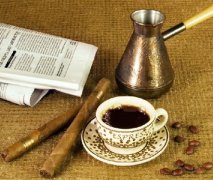What are the characteristics of coffee beans at Manor Lina in Nicaragua? how much is the coffee at Lina Manor?

For professional baristas, please follow the coffee workshop (Wechat official account cafe_style)
What are the characteristics of coffee beans at Manor Lina in Nicaragua? how much is the coffee at Lina Manor?
Some of the fruits that stand out from the classifier are transported to the depulper for peeling and pulp. The so-called "honey-treated" coffee (honeyprocess) describes coffee as sweet as honey, not really processed with honey. The coffee kernel which has been peeled but still adheres to the pulp is directly dried, and some fructose will be absorbed by the core. This method has different names in different countries, such as pulped natural, semi washed and so on.
Nicaragua Nicaragua
Population: 6071000
Nicaragua has some smaller growing areas, including Madriz (Madriz), Managua (Managua), Boaca and Carazo (Carazo), which are not listed below but actually produce some excellent coffee.
JINOTEGA
The name of the Xenotegav region, as well as the name of its capital, comes from the word "xinotencatl" in Nahuatl, but opinions vary on the meaning of the word, either "urban elderly" or "Jinocuabos's neighbor", but the latter may be more accurate. The economy of the region has long been dependent on coffee and it remains the main producing area in Nicaragua.
Altitude: 1100-1700m
Harvest: December-March
Variety: Caturra, bourbon
MATAGALPA
Matagalpa, which is named after the capital city, has set up a coffee museum. Coffee in this area is produced by a mixture of large estates and cooperatives.
Altitude: 1000-1400m
Harvest: December-February
Variety: Caturra, bourbon
Nicaragua is one of the major coffee-producing countries, producing high-quality coffee. Even coffee from the Antigua Mountains of Guatemala, which is famous in Asia, imports raw beans from Nicaragua. Nicaraguan coffee is not well-known in Asia. But in fact, Nepalese coffee is already famous all over the world (Starbucks has many cooperative coffee farmers in Nepal), while the quality of coffee produced by several coffee producing countries in Central America, such as Guatemala, Costa Rica and Nicaragua, is similar, mainly due to weather conditions, soil fertility, planting height and other conditions.
Among them, in Costa Rica, where the government strictly controls the use of water, coffee farmers have created honey treatments named to retain "different thickness of flesh", including yellow honey (yellow honey) and red honey (red honey), which have the thinnest pulp layer, and black honey (black honey), the famous owner of the former Costa Rican COE champion La Brumas de Zurqui. Traditionally, Nicaraguan coffee is mainly washed with water, but because the trend of "honey treatment" has become popular in China and the United States in recent years, some batches are "tailor-made" at the request of buyers.
High-quality Nicaraguan coffee is also grown in the northern and central highlands of the country. The best coffee is produced in Matagalpa. The coffee produced here is highly respected by coffee lovers all over the world and gradually valued by the boutique community. Abundant precipitation, suitable temperature, high altitude, fertile soil and unique planting ecology are the prerequisites for creating high-quality Nicaraguan coffee.
The excellent Nicaraguan coffee is among the highest in the world, it is mild and delicious, moderate granule, very fragrant. In many countries, coffee production has been seriously affected for political reasons. Nicaraguan coffee industry is no exception. The 1979 revolution forced coffee planters to flee to Miami. A period of uncertainty followed, when the government considered whether to redistribute land (including many plantations), which led to a shortage of coffee and a decline in production, from more than 1 million bags in the early 1970s to less than 600000 bags in 1990
Although Nicaragua is a country with a large territory in Central America, it is not a big producer in the coffee world, and its output and reputation are much weaker than that of its neighbor Costa Rica. But the high-quality Nicaraguan coffee is in the forefront of coffee beans in the world and enjoys a good reputation.
The ideal planting conditions of coffee trees are as follows: the temperature is between 15 degrees and 25 degrees, and the annual rainfall must reach 1500 mm to 2000 mm. At the same time, the rainfall time should be in line with the flowering cycle of coffee trees.
Nicaragua is one of the poorest countries in Central America. Due to its poor economic foundation, the coffee industry is still relatively backward, while coffee farmers are in extreme poverty. Fortunately, Nicaraguan coffee has received some foreign aid funds to improve the quality of its coffee.
Nicaragua is an economically backward agricultural country, is one of the poorest countries in Central America, the unemployment rate is very high, people live in poverty, and coffee is Nicaragua's pillar industry, producing nearly 100,000 tons of coffee beans every year. Due to the poor economic foundation, the coffee industry is still relatively backward, and coffee farmers are also in a relatively poor state.
Important Notice :
前街咖啡 FrontStreet Coffee has moved to new addredd:
FrontStreet Coffee Address: 315,Donghua East Road,GuangZhou
Tel:020 38364473
- Prev

Description of coffee bean flavor in Gujiso producing area how to drink coffee in Shaqiso producing area
For the exchange of professional baristas, please pay attention to the coffee workshop (Wechat official account cafe_style) Gujiso coffee bean flavor description how to drink coffee in Shakiso producing area located in the southeast of the famous Yega snow coffee producing area, it is the highest region in Ethiopia, with an average elevation of more than 1800 meters. The significant temperature difference between day and night makes the growth of coffee beans more complete and sweet.
- Next

How about coffee at Manor Lina, Nicaragua? how many flavors are there in Lina Manor?
Professional barista communication please pay attention to the coffee workshop (Wechat official account cafe_style) Nicaragua Guarina Manor single coffee how many kinds of flavor coffee trees the ideal planting conditions are: the temperature between 15 degrees-25 degrees temperature climate, and the annual rainfall must reach 1500 mm-2000 mm, at the same time the rainfall time, to be able to match
Related
- Does Rose Summer choose Blue, Green or Red? Detailed explanation of Rose Summer Coffee plots and Classification in Panamanian Jade Manor
- What is the difference between the origin, producing area, processing plant, cooperative and manor of coffee beans?
- How fine does the espresso powder fit? how to grind the espresso?
- Sca coffee roasting degree color card coffee roasting degree 8 roasting color values what do you mean?
- The practice of lattes: how to make lattes at home
- Introduction to Indonesian Fine Coffee beans-- Java Coffee producing area of Indonesian Arabica Coffee
- How much will the flavor of light and medium roasted rose summer be expressed? What baking level is rose summer suitable for?
- Introduction to the characteristics of washing, sun-drying or wet-planing coffee commonly used in Mantenin, Indonesia
- Price characteristics of Arabica Coffee Bean Starbucks introduction to Manning Coffee Bean Taste producing area Variety Manor
- What is the authentic Yega flavor? What are the flavor characteristics of the really excellent Yejasuffi coffee beans?

